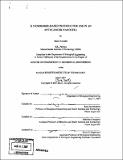A dendrimer-based prodrug for use in an anti-cancer nanocell
Author(s)
Awasthi, Samir
DownloadFull printable version (3.612Mb)
Other Contributors
Massachusetts Institute of Technology. Biological Engineering Division.
Advisor
Ram Sasisekharan and Shiladitya Sengupta.
Terms of use
Metadata
Show full item recordAbstract
Cancer science is a heavily researched and rapidly changing field. Cutting edge research consistently reveals unique features of tumors that can be exploited for treatment. For example, it is well known that cells of varying tumor types have unique molecular markers and cell-surface receptors - fingerprints of sorts - that set cancerous cells apart from healthy cells. Furthermore, the tumor microenvironment has been explored to the point that its unique fluid mechanical and biochemical properties are well understood in the context of tumor growth and survival. However, very little of this research has penetrated clinical medicine. The purpose of this thesis is to present a recent concept in cancer therapy: an anti-cancer nanocell that is capable of the spatial and temporal targeting of drugs to tumor cells. The combination of targeting mechanisms designed into the nanocell is a product of our current understanding of tumors. The design serves to improve the effectiveness of inexpensive, out-of-patent cytotoxic and anti-angiogenic drugs to standards representative of modern research. Efforts towards improving the efficiency of the nanocell, with regards to both drug loading and tumor cell targeting, are presented and discussed. (cont.) The synthesis of various polymer-ligand conjugates for use in the improved nanocell is reported, as is the development of a prodrug consisting of a generation three polyamidoamine dendrimer conjugated to methotrexate via an ester bond; cell studies demonstrating the effectiveness of the prodrug are included. The expandability of the nanocell is also explored, because ultimately, the nanocell must be robust enough to accommodate both tumor-type and population variability.
Description
Thesis (M. Eng.)--Massachusetts Institute of Technology, Biological Engineering Division, 2007. Includes bibliographical references.
Date issued
2007Department
Massachusetts Institute of Technology. Department of Biological EngineeringPublisher
Massachusetts Institute of Technology
Keywords
Biological Engineering Division.